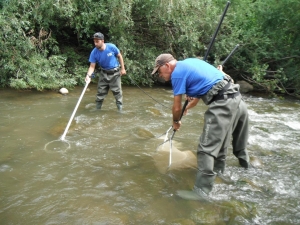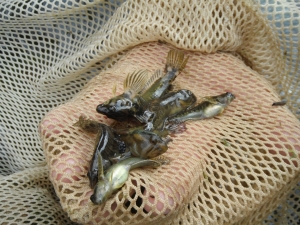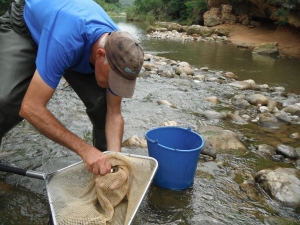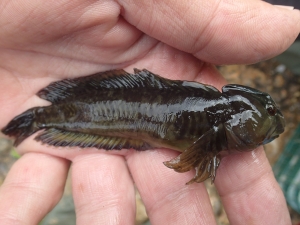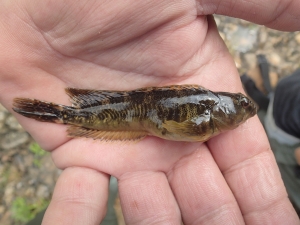The first reinforcement population of freshwater blenny (Salaria fluviatilis) has been taken in Fluvià during the month of June
In the framework of the LIFE Potamo Fauna and to consolidate the recovery of the Naiad Unio Elongatulus in the basins of the rivers Ter and Muga until 2017 is expected to carry out various reinforcements with native fish population guests like the Mediterranean Barbel (Barbus meridionalis), Catfish (Squalius laietanus) and Freshwater Blenny (Salaria fluviatilis). This June has started with one of the three species, namely the freshwater blenny and traslocaments have been made in the middle course of the river Fluvià to upper stretches of the same river where the species had disappeared more than three decades ago. In total the project will act in the following areas of Natura2000 Network: Banks of Lower Ter, Xuclà and Riudelleques, Llémena and Brugent Rivers, and the River Fluvià in the Volcanic Zone of the Garrotxa.
One of the key factors that explain the decline of long naiad is the deteriorating fish stocks. In the basins of the Fluvià and Ter, in the river stretches all the native species are scarce. In fact, we often only find a single native species of fresh water in these areas. This deterioration is the result of a general deterioration of the river environment. However, lately, there has been a recovery of large sections, especially as it relates to water quality. Everything indicates that there could be a recovery of native fish populations in many stretches of river, but this is because the remaining populations are in specific sectors, and there are still some problems of river connectivity with numerous artificial barriers on these rivers.
The situation of the Freshwater Blenny is that is a threatened species in Catalan scale and is quite precarious in the basins of the Fluvià and Ter, where only maintains some core sections on very localized places, yet these sections populations have high densities. This species will only be translocated in sectors located in major river axes, like main courses of Ter and Fluvià. The total population extracted from the natural environment for their translocation to other sectors ranges from a minimum of 100 to 1,000 individuals.
The traslocation of fishes is done with captures of the individuals using electric fishing and immediate transfer of the fishes to release in the new sectors. These are performed within the same river basin, preventing fish from a moving river basin to another. Other criteria taken into account are not affected the source populations, the distance between extraction sites and loose and avoid translocations towards sectors with a high presence of exotic fish.
LIFE Potamo Fauna has an overall budget of 1.9 million euros, 50% funded by the European Union. Between 2014 and 2017 will act in 11 Natura 2000 areas in the province of Girona recovering and preserving long-term multiple endangered species. There will be carried out reinforcements population and improvements of habitats of species such as the white-footed crayfish, fish, amphibians and turtles. The project has enabled us to consolidate a team of 24 people for four years.
The Consorci de l’Estany acts as a coordinating beneficiary and associated beneficiaries are the Consorci del Ter, the Generalitat de Catalunya through the Departament d’Agricultura, Ramaderia, Pesca, Alimentació i Medi Natural, Forestal Catalana SA, the Amics de la Tortuga de l’Albera and the Universidad del País Vasco-Euskal Herriko Unibertsitatea. As co-financers there are the Ajuntaments de Banyoles and Porqueres, the Diputació de Girona, Aigües de Banyoles, SAU and the Consorci Esportiu de l’Estany de Banyoles.



